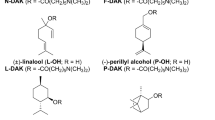Abstract
In a previous study, a synergistic retardation effect of 1,4-cyclohexanediol and 1,2-hexanediol on percutaneous absorption and penetration of metronidazole (MTZ) was discovered. A complex formation between 1,4-cyclohexanediol and 1,2-hexanediol was proposed to be responsible for the observed effect. The objective of this study was to investigate the necessity of hydroxyl group and the ring structure in 1,4-cyclohexanediol on percutaneous absorption and penetration of MTZ. Eleven formulations were studied in an in vitro porcine skin model using glass vertical Frans Diffusion Cell. 1,4-Cyclohexanediol was changed into 1,4-cyclohexanedicarboxylic acid, trans (and cis)-1,2-cyclohexanediol and 1,6-hexanediol, respectively, to study if H-bonding or ring structure would influence the retardation effect. MTZ was applied at infinite dose (100 mg), which corresponded to 750 μg of MTZ. Based on modifier ratios (MR) calculated by the flux values, the retardation effect on percutaneous absorption and penetration of MTZ was found in the formulations containing 1,4-cyclohexanedicarboxylic acid or cis-1,2-cyclohexanediol (MR values were 0.47 for which only contains 1,4-cyclohexanedicarboxylic acid, 0.74 for the formulation containing both 1,4-cyclohexanedicarboxylic acid and 1,2-hexanediol, and 0.90 for the formulation containing cis-1,2-cyclohexanediol and 1,2-hexanediol, respectively). The results showed that the hydroxyl group and structure of 1,4-cyclohexanediol played a significant role in retardation effects and provided valuable insight on the mechanisms of retardation effect through structure–activity relationships.




Similar content being viewed by others
References
Melot M, Pudney P, Williamson AM, Caspers PJ, Pol A, Puppels GJ. Study the effectiveness of penetration enhancers to deliver retinal through the stratum cornum by in vivo confocal Raman spectroscopy. J Control Release. 2009;138:32–9.
Kaushik D, Costache A, Michniak-Kohn B. Percutaneous penetration modifiers and formulation effects. Int J Pharm. 2010;386:42–51.
Purdon CH, Azzi CG, Zhang J, Smith EW, Maibach HI. Penetration enhancement of transdermal delivery—current permutations and limitations. Critical review in therapeutic drug carrier systems. Crit Rev Ther Drug Carrier Syst. 2004;21:97–132.
Kanikkannan N, Kandimalla K, Lamba SS, Singh M. Structure-activity relationship of chemical penetration enhancers in transdermal drug delivery. Curr Med Chem. 2000;7(6):593–608.
Patel H, Berge W, Cronin MTD. Quantitative structure–activity relationships (QSARs) for the prediction of skin permeation of exogenous chemicals. Chemosphere. 2002;48(6):603–13.
Domagala JM. Structure–activity and structure–side-effect relationships for the quinolone antibacterials. J Antimicrob Chemother. 1994;33(4):685–706.
Vavrova K, Zbytovska J, Hrabalek A. Amphiphilic transdermal permeation enhancers: structure–activity relationships. Curr Med Chem. 2005;12(19):2273–91.
Asbill CS, Michniak BB. Percutaneous penetration enhancers: local versus transdermal activity. Pharm Sci Technol Today. 2000;3(1):36–41.
Cronin MT, Dearden JC, Moss GP, Murray-Dickson G. Investigation of the mechanism of flux across human skin in vitro by quantitative structure–permeability relationships. Eur J Pharm Sci. 1999;7:325–30.
Chavda S, Bahadur P. Micellization of a cationic Gemini surfactant in aqueous solutions with different alkanols and alkanediols as additives: effect of nonpolar chain and position of hydroxyl groups. J Mol Liq. 2011;161:72–7.
Wertz PW. Epidermal lipids. Semin Dermatol. 1992;11(2):106–13.
Roberts MS, Pugh WJ, Hadgraft J, Watkinson AC. Epidermal permeability–penetrant structure relationships. 1. An analysis of methods of predicting penetration of monofunctional solutes from aqueous solutions. Int J Pharm. 1995;126:219–33.
Hadgraft J, Peck J, Williams DG, Pugh WJ, Allan G. Mechanisms of action of skin penetration enhancers/retarders: azone and analogues. Int J Pharm. 1996;141:17–25.
Roberts MS, Pugh WJ, Hadgraft J. Epidermal permeability: penetrant structure relationships. 2. The effect of H-bonding groups in penetrants on their diffusion through the stratum corneum. Int J Pharm. 1996;132:23–32.
Pugh WJ, Roberts MS, Hadgraft J. Epidermal permeability—penetrant structure relationships: 3. The effect of hydrogen bonding interactions and molecular size on diffusion across the stratum corneum. Int J Pharm. 1996;138:149–65.
Plessis J, Pugh WJ, Judefeind A, Hadgraft J. The effect of the nature of H-bonding groups on diffusion through PDMS membranes saturated with octanol and toluene. Eur J Pharm Sci. 2002;15:63–9.
Plessis J, Pugh WJ, Judefeind A, Hadgraft J. Physico-chemical determinants of dermal drug delivery: effects of the number and substitution pattern of polar groups. Eur J Pharm Sci. 2002;16:107–12.
Li N, Jia WB, Zhang Y, Tan FP, Zhang J. Synergistic effect of 1,4-cyclohexanediol and 1,2-hexanediol on percutaneous absorption and penetration of metronidazole. Int J Pharm. 2011;415:169–74.
Howes D, Guy R, Hadgraft J. Methods for assessing percutaneous absorption. The report and recommendations of ECVAM Workshop 13. Altern Lab Anim. 1996;24:81–106.
Batheja P, Song Y, Wertz P, Michniak-Kohn B. Effects of growth conditions on the barrier properties of ahumanskin equivalent. Pharm Res. 2009;26:1689–700.
Goodman M, Barry BW. Action of penetration enhancers on human skin as assessed by the permeation of model drugs 5-fluorouracil and estradiol. I. Infinite dose technique. J Invest Dermatol. 1988;91:323–7.
Elias PM, Goerke J, Friend DS. Mammalian epidermal barrier layer lipids: composition and influence on structure. J Invest Dermatol. 1977;69:535–46.
Hughes AL. Evolutionary diversification of the mammalian defensins. Cell Mol Life Sci. 1999;56:94–103.
Cross SE, Roberts MS. The effect of occlusion on the epidermal penetration of parabens from a commercial test ointment, acetone and ethanol vehicles. J Invest Dermatol. 2000;115:914–8.
Meyer W, Schwarz R, Neurand K. The skin of domestic mammals as a model for the human skin, with reference to the domestic pig. Curr Prob Dermatol. 1978;7:39–52.
Sato K, Sugibayashi K, Morimoto Y. Species differences in percutaneous absorption of nicorandil. J Pharm Sci. 1991;80:104–7.
Li N, Su Q, Tan FP, Zhang J. Effect of 1,4-cyclohexanediol on percutaneous absorption and penetration of azelaic acid. Int J Pharm. 2010;387:167–71.
Author information
Authors and Affiliations
Corresponding authors
Rights and permissions
About this article
Cite this article
Zhang, Y., Tan, F., Jia, W. et al. Effect of Hydroxyl Groups and Rigid Structure in 1,4-Cyclohexanediol on Percutaneous Absorption of Metronidazole. AAPS PharmSciTech 15, 973–980 (2014). https://doi.org/10.1208/s12249-014-0125-8
Received:
Accepted:
Published:
Issue Date:
DOI: https://doi.org/10.1208/s12249-014-0125-8




